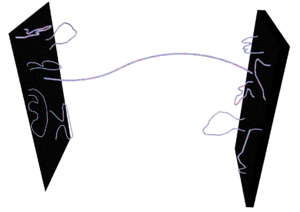Brane facts for kids
A brane is a special kind of object in string theory and similar ideas like supergravity. Think of it as a way to imagine a point particle (like a tiny dot) but in more than just one dimension.
Imagine a tiny dot – that's a 0-dimensional object. Now imagine a string – that's a 1-dimensional object. Branes are like these, but they can have even more dimensions! They are always moving through spacetime and follow the rules of quantum mechanics. Branes have mass, and they can also have other features, like electric charge.
What are p-branes?
A simple way to understand branes is by their dimension.
- A point particle is like a brane with zero dimensions. We call this a 0-brane.
- A string is like a brane with one dimension. We call this a 1-brane.
Scientists can also think about branes with even more dimensions. A brane that has p dimensions is usually called a p-brane. For example, a 2-brane would be like a flat surface or a membrane.
The word "brane" comes from "membrane," which is a thin, flexible sheet, like a soap bubble. The term "p-brane" was first used by a physicist named M. J. Duff and his team in 1988.
When a p-brane moves through spacetime, it creates a larger space called its worldvolume. This worldvolume has one more dimension than the brane itself. So, a 0-brane (a point) leaves a 1-dimensional line as its worldvolume. A 1-brane (a string) leaves a 2-dimensional surface as its worldvolume.
D-branes and open strings

In string theory, strings can be either open or closed.
- An open string is like a piece of string with two ends.
- A closed string is like a loop, with no ends.
D-branes are a very important type of brane that appear when we talk about open strings. Imagine an open string moving around. Its two ends must always stay attached to a D-brane. The "D" in D-brane stands for "Dirichlet," which is a mathematical term describing how the ends of the string are "fixed" to the brane.
One cool thing about D-branes is that the way things behave on their surface (their worldvolume) can be described by something called a gauge theory. This is a type of physics theory that is also used to explain how tiny particles behave in the Standard Model of particle physics, which describes the basic building blocks of our universe. This connection has helped scientists understand more about both gauge theories and string theory. For example, it led to the discovery of the AdS/CFT correspondence, which is a powerful tool that helps physicists solve difficult problems in gauge theory by turning them into easier problems in string theory.
Related pages
Images for kids
-
A cross section of a Calabi–Yau manifold
See also
 In Spanish: Brana para niños
In Spanish: Brana para niños


